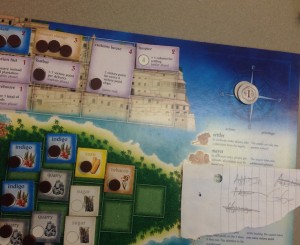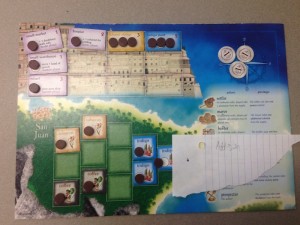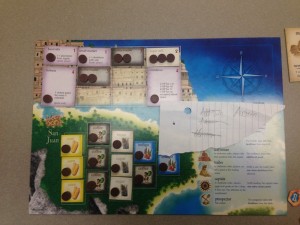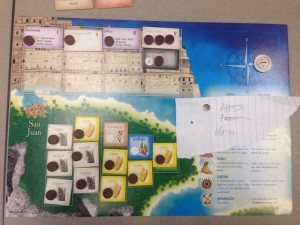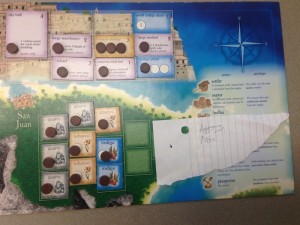Max Owen
Session Report-Puerto Rico
For the gamers out there looking for an intensely layered and engaging board game experience, look no further than Puerto Rico. Puerto Rico is a 3 to 5 player board game produced by a German manufacturer, called Alea. Since its introduction in 2004, it consistently scores among the highest ranks for popularity on BoardGameGeek.com. The theme of Puerto Rico is a very creative premise. Each player gets an identical board that represents the colony of San Juan circa Pre- US Revolutionary War. The objective of the game is to construct the most economically productive San Juan colony. This can be done by cultivating crops to trade for doubloons, and constructing buildings for the colony. Whoever has the most victory points at the end of the game wins. Puerto Rico’s unique mechanic structure forces to players to simultaneously plan a long-term strategy and quickly adapt their strategy to changing circumstances. The trickiest part with planning a strategy in Puerto Rico is making sure that moves(role choices) that are beneficial to you are not more beneficial to other players as well. I’ll touch more on that in a second. Players are given their crops to start with at random. Players will cultivate their crops and buildings on their respective San Juan colony’s by choosing one of seven roles for each round. The roles are as follows: settler, mayor, builder, craftsman, trader, captain, and prospector. It is how players determine which roles to take on per round that Puerto Rico displays its ingenuity. At the beginning of each round, the player that chooses the first role is the governor. The role that the governor chooses for that round not only effects his turn, but all the other players’ turns’ within that round. Each player must act as the role that the governor picked at the beginning of the round. If circumstances do not allow the player to carry out the role, he must forfeit his turn for that round and take the prospector role. At the end of each round, a doubloon is placed on the roles that were not used on that round. The governor card is then passed to the next player, who chooses the role for the next round. The key to effective strategy in Puerto Rico is bending the roles that you do not choose into your long-term strategy for when you do get the governor card. Since it is difficult to anticipate how other players will act as governor, you must be able to adapt your strategy to the turbulently changing circumstances brought on with each new round.
For the game between Gabe, Addison, Austin, Hunter, and myself; crop cultivation was the dominating strategy. This can be attributed to the fact that this was all of our first time playing Puerto Rico, and crop cultivation is the easiest strategy to gain doubloons and victory points. The crops that players began with influenced their strategy through out the game. Addison, Gabe, and myself were all dealt indigo crops to begin the game, while Austin and Hunter were dealt corn crops. Our apportionment of indigo crops dictated our early round turns establishing indigo factories to make profit. Austin and Hunter’s corn crops gave them an early advantage because corn did not need factories in order to be traded/shipped. Not having to deal with factory constraints allowed them to be more profitable early, which gave them a more flexible strategy. Both Austin and Hunter focused solely on expanding corn plantation early in the game. They were able to do this quicker than the other players by building a hacienda early on. This allowed them to grow their plantation faster, which in turn gave them more crops to export. After gaining the initial financial investment, Austin started diversifying his plantation with more valuable cash crops like coffee and sugar. These translated into more buildings established which gave him the edge in the end. Gabe, Addsion, and myself were severely hampered by our indigo crops early on. I made the decision early to fill my plantation with quarries as opposed to crops. A quarry has the advantage of making buildings cheaper, and my hope was that I would have enough quarries to compensate for my lack of cash crops. My inability to establish a flow of cash from my crops restricted my options throughout the game. Gabe and Addison made a better situation out of their initial indigo crops from translating early profits into cheap buildings. Austin ended up with the most victory points due to his crop cultivation and town buildings.